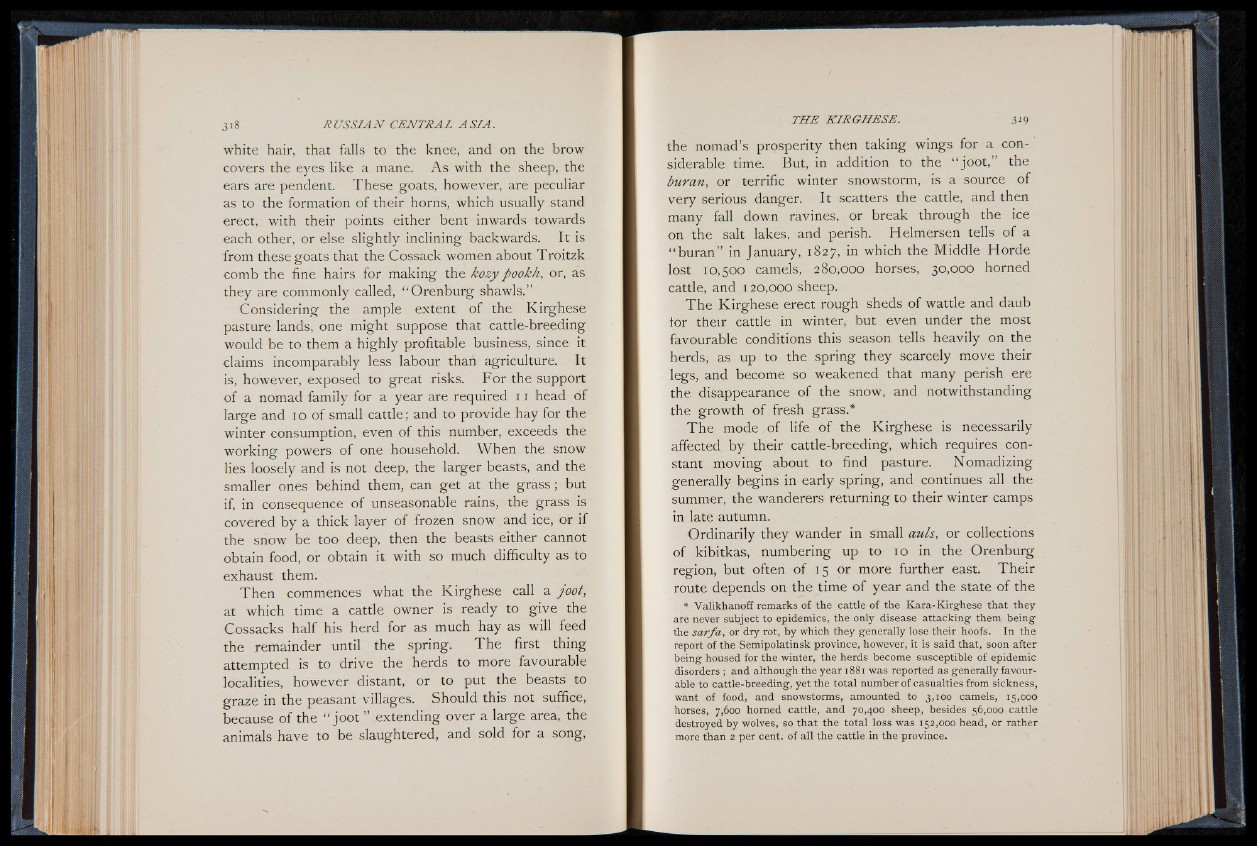
white hair, that falls to the knee, and on the brow
covers the eyes like a mane. As with the sheep, the
ears are pendent. These goats, however, are peculiar
as to the formation of their horns, which usually stand
erect, with their points either bent inwards towards
each other, or else slightly inclining backwards. It is
from these goats that the Cossack women about Troitzk
comb the fine hairs for making the kozy pookh, or, as
they are commonly called, “ Orenburg shawls,”
Considering the ample extent of the Kirghese
pasture lands, one might suppose that cattle-breeding
would be to them a highly profitable business, since it
claims incomparably less labour than agriculture. It
is, however, exposed to great risks. For the support
o f a nomad family for a year are required 11 head of
large and 10 of small cattle; and to provide hay for the
winter consumption, even of this number, exceeds the
working powers of one household. When the snow
lies loosely and is not deep, the larger beasts, and the
smaller ones behind them, can get at the g ra ss; but
if, in consequence of unseasonable rains, the grass is
covered by a thick layer of frozen snow and ice, or if
the snow be too deep, then the beasts either cannot
obtain food, or obtain it with so much difficulty as to
exhaust them.
Then commences what the Kirghese call a joot,
at which time a cattle owner is ready to give the
Cossacks half his herd for as much hay as will feed
the remainder until the spring. The first thing
attempted is to drive the herds to more favourable
localities, however distant, or to put the beasts to
graze in the peasant villages. Should this not suffice,
because of the “ joot ” extending over a large area, the
animals have to be slaughtered, and sold for a song,
the nomad’s prosperity then taking wings for a considerable
time. But, in addition to the “ joot,” the
buran, or terrific winter snowstorm, is a source of
very serious danger. It scatters the cattle, and then
many fall down ravines, or break through the ice
on the salt lakes, and perish. Helmersen tells of a
“ buran” in January, 1827, in which the Middle Horde
lost 10,500 camels, 280,000 horses, 30,000 horned
cattle, and 120,000 sheep.
The Kirghese erect rough sheds of wattle and daub
for their cattle in winter, but even under the most
favourable conditions this season tells heavily on the
herds, as up to the spring they scarcely move their
legs, and become so weakened that many perish ere
the disappearance of the snow, and notwithstanding
the growth of fresh grass.*
The mode of life of the Kirghese is necessarily
affected by their cattle-breeding, which requires constant
moving about to find pasture. Nomadizing
generally begins in early spring, and continues all the
summer, the wanderers returning to their winter camps
in late autumn.
Ordinarily they wander in small auls, or collections
of kibitkas, numbering up to 10 in the Orenburg
region, but often of 15 or more further east. Their
route depends on the time of year and the state of the
* Valikhanoff remarks of the cattle of the Kara-Kirghese that they
are never subject to epidemics, the only disease attacking them being
the sarfa, or dry rot, by which they generally lose their hoofs. In the
report of the Semipolatinsk province, however, it is said that, soon after
being housed for the winter, the herds become susceptible of epidemic
disorders ; and although the year 1881 was reported as generally favourable
to cattle-breeding, yet the total number of casualties from sickness,
want of food, and snowstorms, amounted to 3,100 camels, 15,000
horses, 7,600 homed cattle, and 70,400 sheep, besides 56,000 cattle
destroyed by wolves, so that the total loss was 152,000 head, Or rather
more than 2 per cent, of all the cattle in the province.